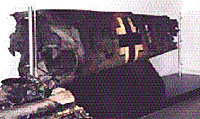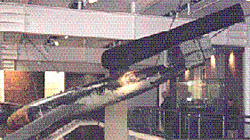 Wreckage from the Messerschmitt used by Rudolf Hess in his flight to England.
Wreckage from the Messerschmitt used by Rudolf Hess in his flight to England.
At the very center of the English-speaking world, and one of its largest cities, London is a virtual heaven for the historically-oriented traveler. Just in the City and Westminster, one can spend hours in the Tower of London, the center of the center, marveling at the Houses of Parliament, Buckingham Palace, and more outstanding houses of worship than most Americans, citizens of a young country, can imagine. London is an ancient city, and the visitor's itinerary should reflect that.
There is one site dedicated wholly to the twenieth-century that should not be forgotten: The Imperial War Museum. It lies off the beaten track from the London Epicenter, south of the Thames in the borough of Southwark. Whereas areas more likely to have American visitors tend to be on the upscale or commercial side, Southwark is decidedly un-trendy, non-touristy, and not an entirely attractive place. It, however, shows a face of London not generally pictured in the tour books.
The museum sits in a rare state of comparative majesty in northern Southwark, not too far from the Thames. Its large scale and eighteenth-century neo-classical architecture, complete with dome and rotunda, call to mind an American state capital or perhaps a courthouse or city hall. But this is England. The Imperial War Museum now occupies a former home of the Royal Bethlehem Hospital, the mental institution better known as Bedlam.
What one notices second, or even first, depending on the angle of view, are the cannons outside the front entrance. These are not the ordinary muzzle-loading field guns. These are a pair of enormous 15-inch battleship guns, taken from HMS Resolution and Ramillies.
Inside, once past the inevitable security check, the rotunda is impressive at first glance. It is a large open area filled with a mix of vehicles and artillery from the beginning to the end of the twentieth-century British military history. There is a small double-decker bus that transported troops in World War I, Bernhard Law Montgomery's Grant command tank from his stint in the desert, and a Polaris missile from a Royal Navy submarine.
Perhaps the most interesting object on the floor is a German artillery spotting periscope. This is no mere tripod-mounted device, but a trailer-mounted, telescoping means of sighting the fall of shot from behind high trees and other concealment. The periscope still works, and through it the visitor can see St. Paul's Cathedral, over two miles away, through a window at the base of the dome.
 V-1 "Buzz Bomb" -- the world's first cruise missile.
V-1 "Buzz Bomb" -- the world's first cruise missile.
There are several World War II aircraft hanging overhead. The Spitfire can be viewed as obligatory, and perhaps so can the P-51 Mustang, in American colors. There are two major rarities too, from the Luftwaffe. The museum houses a V-1 "Doodlebug" cruise missile, and an He-162 volksjäger jet fighter.
Upon closer examination, a visitor can notice that the airplanes are not in the most immaculate condition. Paint peels, and panels appear to work loose, only to stay that way. It is a far cry from the superb care shown to the aircraft in the US Air Force Museum in Ohio, or the armored fighting vehicles housed in Britain's Bovington Tank Museum, in Dorset.
On an upper concourse There is one plane that rests in pieces, necessary for the circumstances in which it reached the United Kingdom. It is a couple of sections from Rudolf Hess' Me 110, in which he made his bizarre flight to Scotland.
Though all of this occupies the center of the Imperial War Museum, it can be argued that it is, thematically at least, on the fringes. The real heart of the museum lies in the halls that radiate out from the rotunda. These are arranged by period and theater of war: For example, World War II is represented by halls on the European War, the Pacific War, and the British homefront. Furthermore, there is a central theme of the experience of war by people instead of weapons, maps and trophies. These are present in abundance, to be sure, but their presentation serves the perspective of the soldier and noncombatant, instead of standing strictly on their own. For this reason a soccer ball kicked by an officer through No Man's Land on the first day of the Somme warrants equal billing with the kind of machinegun that ended his and so many other lives that day.
Other areas try to give an even deeper impression of the experience, operating as a kind of simulator. One, on trench warfare, takes the visitor through a First World War trench on a typical day of boring misery and random, low-intensity death. It does give some idea of the darkness of the environment, and the claustrophobia of trench life, something that history books too often overlook.
About all that is missing from the exhibit is an assortment of trench smells. This is actually quite within the capabilities of a British museum; the wartime tunnels under Dover Castle feature cooking smells in the kitchen, and antiseptic in the hospital. However, it is probably fortunate that the Imperial War Museum does not go that far, due to the chances that visitors would be nauseated by the stench of cordite, unwashed and louse-infested bodies, and rotting flesh.
 Sherman tank
Sherman tank
Anyone who reads books and magazines on military history has no doubt seen many illustrations credited to the Imperial War Museum. The museum does have a large catalogue of pictures, and its gallery of military art alone might be worth a visit for its own sake. During my visit in September 1999, it had two temporary exhibitions. One was dedicated to winners of the Victoria Cross, Britain's highest military award, and the George Cross, which can be won by policemen and other public servants for bravery. It told the story of the VC, and its physical origins in the bronze of cannons seized from the Russians during the Crimean War. For the most part, it was a very low-keyed affair, simply presenting the portraits, stories, and medals won by the recipients throughout the twentieth century.
The second was layered with irony. It celebrated British military intelligence and counterintelligence. The bitter humor lay in the fact that, at the time, the country suffered through another embarrassing spy scandal. The museum has two outlying facilities that warrant separate visits. The closest is HMS Belfast, a World War II cruiser, which is now moored in the Thames near Tower Bridge. Further afield to the north, the Imperial War Museum also operates an aircraft museum at Duxbridge, on the site of a former Royal Air Force field that was later used by the American 8th Air Force. The Museum also maintains the Cabinet War Rooms in the heart of Westminster.
There are flaws in the Imperial War Museum's presentation. The hardware around the rotunda and its galleries is arranged in a manner that borders on the haphazard, and if aluminum could be moth-eaten, then that would describe the aircraft there. At times one can see a near triviality in some of the items in the more coherently set-up halls.
Despite these shortcomings, it is a most worthy destination for the London visitor, or resident for that matter, interested in British military history.
GETTING THERE
Getting to London is the easy part. For an American, it's a matter of flying to Heathrow or Gatwick airports, and probably taking the train to Paddington or Waterloo stations in the city itself. If one is especially fortunate, as I was in September 1999, there might be a local relative or friend willing to drive. If given the chance to drive in London, my advice is: Don't even think about it. It is, by far, the most confusing city I have seen in my entire life. The streets follow irregular patterns, never seem to run straight more than a few hundred yards, and change names at least every half mile. That does not even touch on the most obvious difference between American and British driving, which is that one drives on the right and left side of the road respectively.
Even walking around the city can be confusing. It is easy to lose sense of direction amidst a pattern of streets with no pattern, and there is a distinct lack of tall buildings upon which to establish bearings. What is one to do? That is simple: Take the Underground. The subway system of metropolitan London is the best way to travel the city, and is far less confusing than the streets above.
The station where I disembarked for the Imperial War Museum is Elephant & Castle, to the southeast. Walk up St. Georges Road to Lambeth Road, and the museum will be on the left. Lambeth North is close as well, to the northwest of the museum. Go southeast on Westminster Bridge Road to St. Georges Road, and look to the right. Waterloo Station, both an Underground station and a primary British Rail terminal, is just a little to the northwest of Lambeth North, on Westminster Bridge Road across Baylis Road.
For more information on the Imperial War Museum and its outlying facilities, see its web site at http://www.iwm.org.uk.
Back to Cry Havoc #31 Table of Contents
Back to Cry Havoc List of Issues
Back to MagWeb Master Magazine List
© Copyright 2000 by David W. Tschanz.
This article appears in MagWeb (Magazine Web) on the Internet World Wide Web. Other military history articles and gaming articles are available at http://www.magweb.com